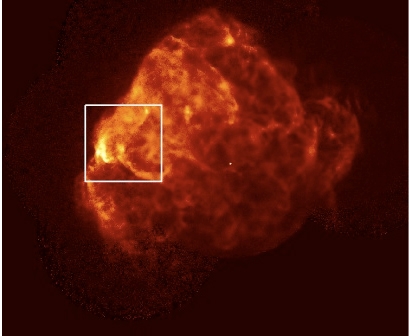Supernovas and X-Rays
Submitted by Marcos Lopez on
When we look at the sky during the night it is possible to appreciate stars of different colors and brightnesses. However, although we may think that stars will bright forever, the stars, as all the existence on the Earth and space, also have their life-cycle. There’s a type of stars called the supergiants that emit lots of luminosity. When a supergiant star collapse with itself in a way that they can produce an explosion, it produces what is known as supernova. A supernova is the process that occurs when a star’s life-cycle ends and explodes. In this process, the supernova explosion may produce a huge amount of energy similar to the one emitted by the Sun that is also a star. A supernova’s remnant is very important because it distributes essential elements in the interstellar media. Eventually, these remnant elements produced in the stars and the supernova cool down, collapse and produce new stars and planets. For this reason, the study of these supernova remnants would bring us key information about the interstellar evolutive process
Directly from the west coast of Puerto Rico, from Mayagüez, Dr. Enectalí Figueroa-Feliciano is a pioneer in the study of remnants of supernovas and to our understanding, one of the few puertoricans experts in this area. Dr. Figureoa-Feliciano, CROEM alumni, completed a BS in mechanical engineering from the University of Puerto Rico in Mayaguez and afterwards, pursued a masters and a PhD in physics from Stanford University, under the guidance of the scientist of Spanish origin Blas Cabrera. At Stanford, Dr. Figureoa-Feliciano did his doctoral studies theorizing and designing quantum calorimeters that are the ones used to study the supernovas remnants. After this, he worked at NASA as an astrophysicist in the Goddard Space Flight Center in where he applied all the theories and prototypes of calorimeters developed in his doctoral studies, to construct X-ray quantum calorimeters. Dr. Figueroa-Feliciano is a pioneer in the development position-sensitive quantum calorimeters that are orders of magnitude of pixels higher than traditional single-pixel X-ray microcalorimeters. Nowadays, Dr. Figueroa-Feliciano is an assistant professor of physics at MIT and is in charge of a big research group and also several projects, featuring the Micro-X project that is an imaging rocket that contains a high resolution X-ray microcalorimeter.
But, what’s the deal between the X-rays, the supernovas and now the rocket?
The supernova remnants emit lots of energy in the form of X-rays and these give us lots of information about the supernova, their parent stars and the interstellar media in where the remnant expands. In order to study these emitted X-rays, it is necessary to use high-resolution X-ray quantum calorimeters. Dr. Figueroa-Feliciano is currently developing novel nigh resolution quantum calorimeters to study the Puppis-A supernova remnant, which it’s thought to be formed 3,700 years ago.
Here is where the rocket part comes in.
In order to study the emitted X-rays from the supernova, it is required to go the space because the X-rays do not penetrate the atmosphere of our planet Earth. For this, Dr. Figueroa-Feliciano and his research group are developing a rocket that will contain the X-ray microcalorimeter, to obtain high resolution images of the supernova remnant. The project is not looking to obtain information of the entire remnant, but only of part of it, as indicated in the figure. This is the region with highest brightness called the Bright Eastern Knot. The rocket is scheduled to launch on January 19th, 2011.
Besides running other projects in the astrophysics field, Dr. Enectalí Figueroa-Feliciano is a volunteer firemen, certified diver, member of the Civil Air Patrol (CAP) and a licensed pilot. If you are interested to learn more about the supernovas and the Micro-X rocket, visit the Micro-X project webpage. To know more about Dr. Enectalí Figueroa-Feliciano visit his profile at CienciaPR or his webpage at MIT.








